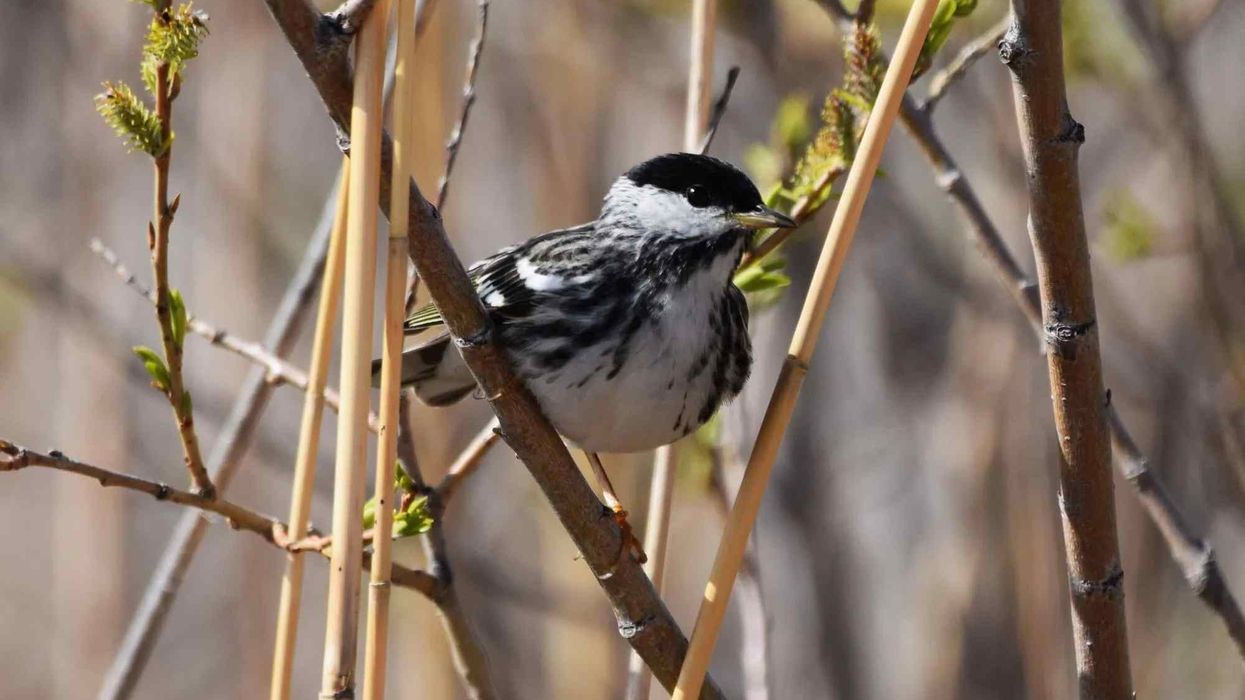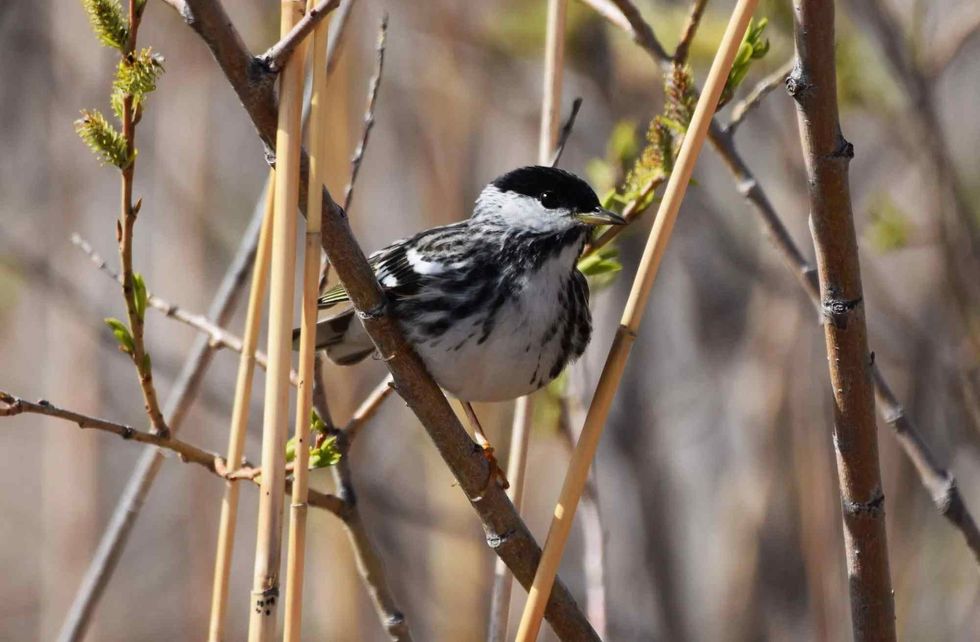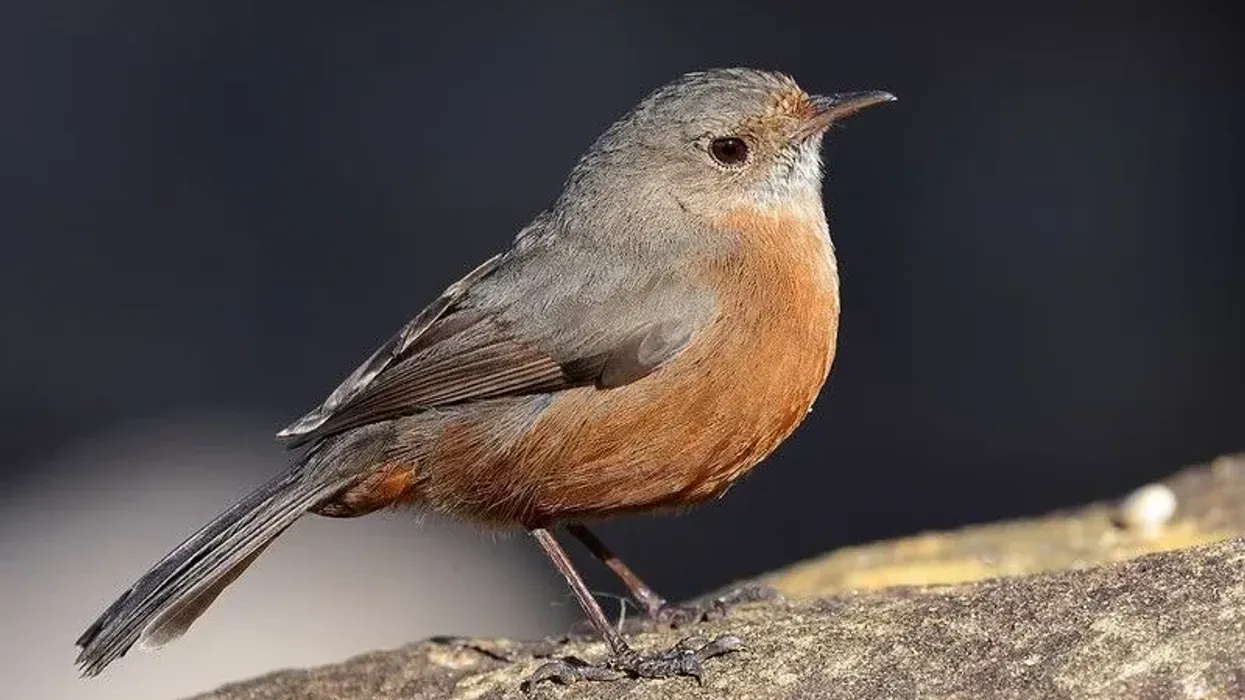The blackpoll warbler (Setophaga striata) is one of the North American birds mostly found in the boreal forest region of Canada, which is also their breeding grounds. They belong to the order Passeriformes, family Parulidae, and genus Setophaga.
These birds of North America are extremely rare to spot and have an overall black and white plumage with a distinctive black cap on the head of the male.
Their feet are yellowish-orange in color and stripes of white and grey can be seen on females.
Both the male and the female have wing bars present on their body. This black and white warbler species draws its name from the black crown and forehead of the male breeding bird.
Blackpoll warblers migrate to northern South America during the fall to reach their wintering grounds, from the boreal forests in Canada, making it the longest migration of any North American bird.
Every fall, blackpoll warblers undertake a long-distance spring migration that extends up to 2,000 miles across open water without stopping until it reaches its wintering grounds in South America.
In some instances, they fly non-stop for more than 75 hours.
Blackpoll warblers have an elliptical migration route as they undertake a different traveling route in fall migration than the one taken during the spring migration. After reading these interesting blackpoll warbler facts, do check our other articles on the palm warbler and the Blackburnian warbler.
Blackpoll Warbler Interesting Facts
What type of animal is a Blackpoll Warbler?
A blackpoll warbler (Setophaga striata) is a bird found inhabiting dense coniferous or broadleaf forests. Thickets and woodlands are their preferred locations. Their population is decreasing due to factors like habitat loss and degradation, and extreme climate change.
What class of animal does a Blackpoll Warbler belong to?
The blackpoll warbler (Dendroica striata) belongs to the family of New World warblers and is a bird of the class Aves. These birds with white cheeks are loud and noisy species of warblers who utter a high-pitched sound to communicate with each other.
How many Blackpoll Warblers are there in the world?
The estimated number of blackpoll warblers living in the wild is 60 million, but their population is decreasing due to global climate change. They are migratory birds and can travel over 2,000 miles in one flight.
Where does a Blackpoll Warbler live?
Blackpoll warblers (Dendroica striata) can be found living in the woods of deciduous trees. Dense vegetation and forests and thickets are also where these tiny birds can be seen. This species is very rare and known for the migratory prowess.
What is a Blackpoll Warbler's habitat?
The habitat of a blackpoll warbler is coniferous or broadleaf forests, wooded areas, canopies and treetops, northern spruce forest, and thickets along the northern Arctic and the Atlantic Ocean. These birds can survive in temperatures as low as -3 degrees Celsius.
Who do Blackpoll Warblers live with?
While migrating, blackpoll warblers get mixed with flocks of swallows and other warblers which leads to confusion for bird-watchers. The female blackpoll warblers generally return to their previous mating territory.
How long does a Blackpoll Warbler live?
The average lifespan of a blackpoll warbler is three to five years. Large numbers of these birds often die due to collisions with tall buildings. They can also be hunted down by other birds like hawks and eagles. Typically, the decreasing numbers of these species can be due to habitat loss and degradation.
How do they reproduce?
The breeding range of blackpoll warblers is tamarack and black spruce forests in Canada. They often get involved in the process of double brooding, where they breed more than once per nesting season.
The average clutch size of a female blackpoll warbler is between one and seven eggs. The incubation period lasts for 10-13 days, while the nestling period is 10-11 days long. The females return to their own territories for mating and mate for life, while the males have multiple mating partners.
What is their conservation status?
According to the IUCN Red List, the conservation status of the blackpoll warbler is listed as Near Threatened. Their population is severely declining due to climate change and habitat degradation. An estimated number of 60 million blackpoll warblers exist in the wild.
Blackpoll Warbler Fun Facts
What do Blackpoll Warblers look like?

Blackpoll warblers are white and black in color, with males having a distinctive black cap and white cheeks, which is absent in females. The legs are orangish-yellow in color, and the average length is 5-6 in. These songbirds have a small beak and a short tail. The females have streaks of white, black, and gray.
How cute are they?
They are little birds that are the size of a sparrow. They are migratory and utter high-pitched vocals. They are songbirds and continuously chirp. They are also known for their long-distance migration. They are pretty cute.
How do they communicate?
Blackpoll warblers communicate with each other through calls and body postures. A blackpoll warbler's song can vary from high-pitched calls to light-toned chirps.
How big is a Blackpoll Warbler?
It is a very little bird, though there are clear differences seen between a male and a female blackpoll warbler. They can be found in northern Canada in the Boreal Forests. Their size ranges between 4.9-5.9 in, while the wingspan ranges between 7.9-9.8 in.
How fast can a Blackpoll Warbler fly?
Blackpoll warblers fly at a speed of 27 miles per hour. They are migratory birds and can cover more than 12,000 miles during the migration period. Birds of this species can fly for 2100 miles without resting. These birds sometimes even catch insects while they are flying.
How much does a Blackpoll Warbler weigh?
The blackpoll warbler's body mass ranges between 0.6-0.7 oz but some have a bodyweight of 0.8 oz and more.
What are their male and female names of the species?
There are no different names for the male and female sex of the species. They are only distinguished according to their sexes and are commonly called male blackpoll warblers and female blackpoll warblers.
What would you call a baby Blackpoll Warbler?
A baby blackpoll warbler is called a nestling or hatchling. When they start flying, they are termed fledglings.
What do they eat?
Blackpoll warblers are typically insectivores and eat insects like aphids, mosquitoes, beetles, gnats, wasps, caterpillars, ants, termites, cankerworms, sawflies, scale insects, etc. This bird species also eats berries, like pokeberries, and a variety of seeds.
Are they dangerous?
No, blackpoll warblers can only be spotted in spring or fall in the boreal forests in northern Canada. This bird species is rarely spotted and often lives in a cover of thick vegetation, thickets, and woodlands. Their plumage also helps them to camouflage with the surrounding.
Would they make a good pet?
The blackpoll warbler is a wild bird that is known for its singing and migration. They should not be kept as pets, as they do not live a long life and spend their entire life flying, mating, and eating.
They should not be caged as they love to fly and can fly at a speed of more than 27 miles per hour.
Did you know...
Blackpoll warblers can fly for a span of 72 hours straight without stopping. During the fall season, the blackpoll warbler molts and their plumage turns yellow-green in color and the breeding males lose their black cap. The population of blackpoll warblers has seen a 88% decline in the last four decades.
The Blackpoll Warbler's call
Blackpoll warblers are songbirds and utter high-pitched, short calls which float throughout the boreal forest. The song only is three seconds long but is repetitive, with rising and falling pitch.
The Blackpoll Warbler migration process
Blackpoll warblers have the most complex migration journey. They start migrating in the fall from western North America and cover a distance of 12,400 miles, back and forth. They migrate from the eastern seaboards, flying over the Atlantic Ocean and finally reaching South America and the Caribbean.
Here at Kidadl, we have carefully created lots of interesting family-friendly animal facts for everyone to discover! Learn more about some other birds including the California quail and the great crested flycatcher.
You can even occupy yourself at home by drawing one of our Blackpoll Warbler coloring pages.










